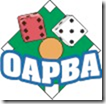 |
Name: Rod Caborn APBA League: Orlando APBA Association Team: Beefers Claim to Fame: estimated 20,000 APBA games played |
Rod Caborn is an APBA Blog reader and not only that, he contributes often. Occasionally, he sends me updates on what his league, the Orlando APBA Association, is up to.
In preparation for this article, Rod sent me his APBA “vitae” as it were. I’m glad he did. It gave me some insight into who he was:
Rod Caborn, a retired marketing executive, resides in Winter Park, Florida. He has been a SABR member since 1985 and an APBA player since 1956, when he was 13 years old. I estimate I have played over 20,000 games, maybe more.
Rod participates in the Orlando APBA Association, a nine-team, face-to-face APBA baseball league in the metropolitan Orlando area. “In 22 years in the league, my team, the Beefers, has been to the OAPBA World Series twice and come up empty both times. Despite hours and hours of watching baseball, poring over printed and online information, I seem have a special inability to select great pitching.”
In addition to his league play, Rod tells me he is an avid APBA replayer. He has completed 12 different replays. He sent me the list and it quite formidable:
- 1883 American Association
- 1906 (full season)
- 1910s Great Teams, integrated
- 1920 American League, integrated
- 1922 (full season)
- 1926 National League
- 1930 (full season)
- 1930s -40s pre WW II American League replay, integrated
- 1930s-40s pre WW II National League Great Teams, integrated
- National League Great Teams (Post WW II)
- American League Great Teams (Post WW II)
But Rod won’t get away without answering a few questions (and he was happy to do so). Here they are.
The APBA Blog: Ok let’s start with the requisite “How did you start playing APBA?” question. Did someone introduce you to the game or did you see it in an ad in a sports magazine?
Rod Caborn: I began playing APBA in 1956. I was (and still am) an avid baseball fan and was intrigued by an advertisement I saw for APBA in, as best I can recall, Street & Smith Baseball.
I still recall, quite vividly, the introduction of the double column cards in 1958 (Richie Ashburn of the Phillies was my first player to hit a second-column double, I remember quite well) and thinking how the change really expanded the game’s ability to represent real-life performance (along with the speed ratings, strikeout and control ratings introduced, I recall, in 1956.
TAB: I’m impressed by and curious about your choices of replays that you have done. Almost all of them are from 1930 and before. What are your reasons for concentrating on early 20th century baseball seasons?
RC: I’ve focused on the early baseball seasons because I wanted to get a feel for what baseball was like in the early days before home runs changed the game. Also, I found it was a good way to really become well acquainted with all of the players from a particular era, not just the stars.
TAB: The game of baseball was played so much differently back then. I’ll bet you’ve done a little research on how to simulate those seasons realistically, didn’t you? Also, what’s your opinion on the APBA cards sets for the seasons you’ve replayed? Do they accurately reflect that style of baseball?
RC: While I thought I was very knowledgeable about baseball history, I learned through APBA that I was not as well acquainted with players from the 19th century and early 20th century as I thought. After playing the American Association from 1883, for example, I learned a great deal more about the history of the game and the players of that time period. Before I started each of my replays, I did a lot of reading and research on the seasons I played out and learned a great deal more about baseball’s earliest days.
TAB: Tell us a little about the Orlando APBA Association. What makes it unique as a league?
RC: Three characteristics distinguish OAPBA.
First, each manager is extremely knowledgeable about the game, both from a managerial standpoint and an administrative standpoint. As a case in point, when we hold our annual draft, there are very few surprises. When a draft pick is announced, most of the time everyone is familiar with the player. Once in a great while, a name pops us that surprises all of us, but not very often.
Second, everyone in the league is respectful of one another. That’s important. Everyone acts in a mature manner. From a gaming standpoint, for example, everyone wants rules that will encourage as accurate a representation of real life performance as possible.
Third, each manager thoroughly knows how to play the game. They are well-versed in the rules, realize the risk and reward for certain plays (e.g. hit and run) and recognize that, over an extended period of time, real-life performance will generally be represented. Sure, once in a while a low-grade pitcher will throw a shutout or a light-hitting infielder will hit a home run, but it evens out over the course of a season. One of the most thrilling games I ever had was in the late 1980s in a Tampa league to which I belonged. John Candelaria (a 2 lefty) shut out the best team in our league on two hits!
TAB: OAPBA has been around for 24 years. Your thoughts on what gives the league its staying power?
 RC: Everyone loves baseball and, by extension, views APBA as a means of playing baseball. Every manager carefully follows the game in real-life and are just as avid about their individual teams in APBA. The combined affection for the game and the companionship that accompanies the love of baseball is a big part of why our managers take time to participate and maintain the league as an ongoing operation.
RC: Everyone loves baseball and, by extension, views APBA as a means of playing baseball. Every manager carefully follows the game in real-life and are just as avid about their individual teams in APBA. The combined affection for the game and the companionship that accompanies the love of baseball is a big part of why our managers take time to participate and maintain the league as an ongoing operation.
To illustrate, Joe Passiatore, who has been the most successful manager in OAPBA’s history, dropped out for a couple of years. He missed it greatly, it turned out so he came back into the league…and continues to dominate it in his second go-round as an OAPBA manager.
We’re very picky about who we let in. No whiners. No one who will disrupt the league with immature behavior. Everyone realizes that APBA is a game, not life or death. If someone’s temperament is not stable or if there are immature characteristics about someone, we will not vote them in.
TAB: Finally, you’ve been a member of SABR for 25 years. Has that enhanced your APBA play?
RC: SABR and APBA are both linked to the history of the game. SABR offers much information about baseball that it brings APBA more to life.
For example, when I replayed teams from 1910s, I found out so much more about the teams and the players via SABR. The info available through SABR goes beyond the statistics and really brings players and the time frame in which they played to life. Plus you meet some extremely smart, knowledgeable people who are willing to share their love of the game. Some are APBA players. Most are not. The common denominator, however, is a passion for the game.
I would like to thank Rod Caborn for taking the time to answer my questions.
I’m enjoying these Fan Profiles and they seem to be generating good feedback, too. We’re learning more about the fans of APBA (Twelve replays, who knew? :))
Here are the other APBA Fan Profiles I’ve done recently.



